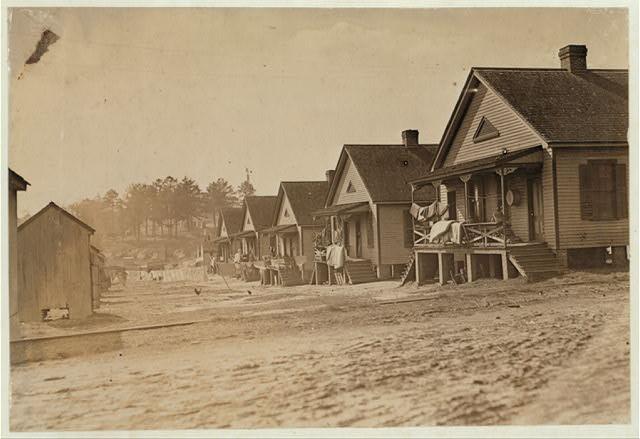Economic development, at what cost?
| (Szdfan) |
| (Bibb City) |
Henry Grady had a vision of prosperity through industrialization in the New South where there was social equality created by economic development. In the time between 1877 and 1908, the New South had an explosion of economic development in line with Grady’s vision. However, the price that was paid with this new progress was the poor working conditions in most factories and businesses. While the South was becoming more industrialized and economically connected, the factory working conditions and low wages, due to the laissez-faire policy of the government, created an economic inequality.
As you see in the picture to the left, these smoke stacks were a sign of the level of development that rose as high as the smoke stacks themselves. This was a common sign of industrialization that came hand in hand with the cotton mills of Macon, Georgia. These mills were one of the most common signs of economic development as the South now manufactured their own cotton products, not simply exporting it to the north. This is the economically independent vision for the south that Grady had hoped for. While the north was supplying capital, it was a huge step in the right direction for the south. Despite the south becoming independent, the industrialization also helped to tie the South together with the rest of the nation as internal transportation systems and communication systems, railroads and the telephone, began to spin a web through southern states. The railways especially, improved the south on an economic scale, increasing profit by cutting down transportation costs. This brought a connection of the northern and southern economies on a national scale. In an article from the Macon Telegraph there is a panic for workers in the Macon mills over wage cuts in Fall River, Massachusetts. This fright over something so far away from their actual location goes to show how interconnected the South now was with the rest of the nation, tying back to economic development (“The Fall River Cut”).

Another sign of the vast reaches of industrialization and the economic development it brought shows up in our very own town of Macon, GA. While Macon was a formidable size, it was nothing near a large city. However, in spite of this, Macon was home to and supported three large cotton mills. This exemplifies how industrialization was in the new south. In another Macon Telegraph article, the city is boasting about being able to support these mills. These people clearly supported Henry Grady’s vision for development in the New South. A second part to this article discusses how the mills hired large numbers of people, thus bringing consistent wages to these people. This constant income was a stepping stone in economic development for the South. This was a sign of an apparent shift from agriculture to industry (“Something About Macon”).
As mentioned above, the working conditions that came with industrialization were not always as fulfilling as Grady had envisioned. The Macon Telegraph, an article was published about Maj. J. F. Hanson’s speech. He was arguing to the Georgia legislature to uphold the current child labor laws, which restricted the work of children under twelve years of age. In his speech, he discussed that aside from his efforts to follow these laws, he undoubtedly had hired children below the age restriction. This was not entirely his fault, however. Families often falsified the age of their children so that they could send them to work, to supplement their abysmal wages. The parents alone working was not enough to support the family and it goes to show the downside of factory work (“Cotton Mills and Child Labor”). Along with economic struggles, the employment of children also kept them from school, depriving them of an education. The mills themselves were attracting a population of uneducated employees that required no skills to operate the machinery. Speaking of machinery, all of the women and children working at these mills were in constant danger of injury. The machines left moving parts out in the open and posed serious hazards to factory workers. These conditions came about without on the job insurance or compensation for any injuries. There was always a ready supply of workers to fill in the low skilled jobs, so mills never had to worry when it came to the dangers present for their workers. 

To wrap things up, Henry Grady’s vision was ambitious but not entirely realistic within the realm of the New South. It seems like this was almost a time of trial and error for the South as they went through the same transition that the North had to endure, about a hundred years earlier. The industry erupted from the tracks of newly forged steel that comprised the railways interconnecting the South and brought a new sense of economic development as it tied together the nation's trade.
Works Cited
"Bibb City: Collected Lives from a Mill Town." Bibb City: Collected Lives from a Mill Town.
Columbus State University, 2 Sept. 2014. Web. 27 Feb. 2015.
“Cotton Mills and Child Labor.” Macon Telegraph [Macon] 30 Jun. 1903: 1-2. Georgia
Historical Newspapers. Web. 13 February 2015. <http://telegraph.galileo
.usg.edu/telegraph/view?docId=news/mdt1903/mdt1903-1499.xml&query=cotton% 20mills%20labor&brand=telegraph-brand>.
"Something About Macon." Macon Telegraph [Macon] 17 Sept. 1902: 6. Georgia Historic
Szdfan. "MennoDiscuss.com." • View Topic. PHPBB, 20 June 2012. Web. 27 Feb. 2015.
“The Fall River Cut.” Macon Telegraph [Macon] 11 Dec. 1897: 1-2. Georgia Historical
Newspapers. Web. 13 February 2015. http://telegraph.galileo.usg.edu/telegraph /view? docId=news/mdt1897/mdt1897-3182.xml&query=cotton%20mill%20wage&brand =telegraph-brand>.
No comments:
Post a Comment